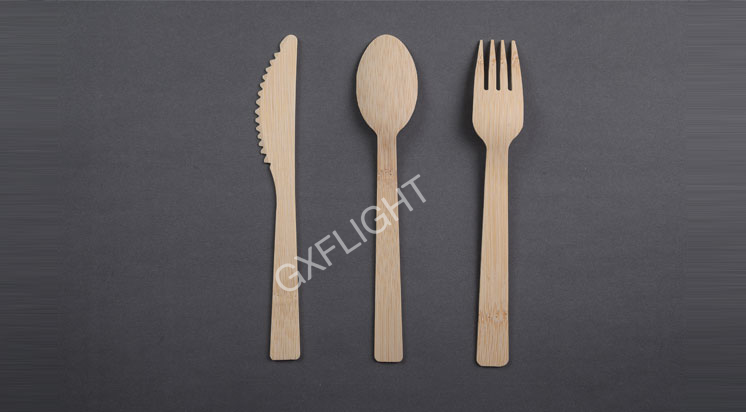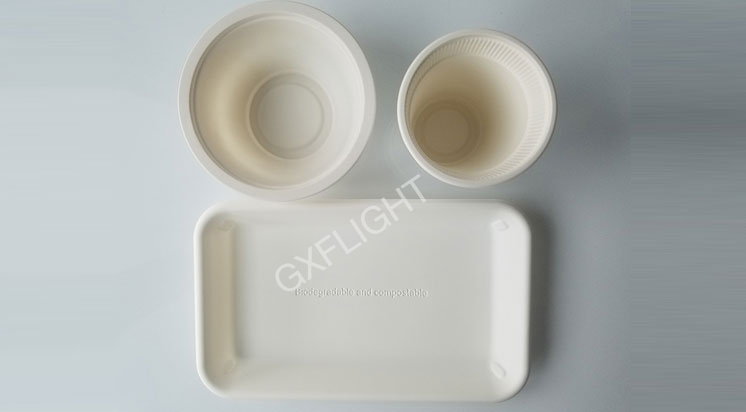Sugarcane dinnerware comprises sugarcane fibers and is a biodegradable and compostable type of dinnerware. It presents an eco-friendly substitute to conventional plastic or paper dinnerware, which may cause environmental harm. The following are some advantages of utilizing sugarcane dinnerware: sustainability, biodegradability, compostability, durability, and suitability for use in microwaves and freezers.
Sugarcane dinnerware is not the only type of biodegradable tableware available on the market. Here are some comparisons between sugarcane dinnerware and other biodegradable tableware options:
Bamboo Dinnerware: Both sugarcane and bamboo dinnerware are biodegradable and compostable. However, bamboo dinnerware is typically more expensive than sugarcane dinnerware. Sugarcane dinnerware is also known to be sturdier than bamboo dinnerware.

Cornstarch Dinnerware: Cornstarch dinnerware is another biodegradable option. However, it is not as sturdy as sugarcane dinnerware and can melt if it comes into contact with hot liquids. Sugarcane dinnerware, on the other hand, is microwave and freezer safe.

Wheat Straw Dinnerware: Wheat straw dinnerware is biodegradable and compostable, like sugarcane dinnerware. However, wheat straw dinnerware may not be as sturdy as sugarcane dinnerware and may break or chip more easily.
Overall, sugarcane dinnerware offers a great balance of affordability, sturdiness, and eco-friendliness compared to other biodegradable tableware options.
Sugarcane dinnerware is produced from bagasse, the fibrous residue remaining after sugarcane juice extraction. The manufacturing process of sugarcane dinnerware involves the following steps:
Collection and Cleaning: Bagasse is sourced from sugar mills and then cleaned to eliminate any impurities.
Soaking and Pulping: The bagasse is soaked in water and pulped to break down fibers, creating a pulp.
Forming and Shaping: High-pressure molding machines are utilized to mold the pulp into the preferred shape such as plates, bowls, cups, and other tableware items.
Drying and Finishing: The molded dinnerware is dried using hot air and then trimmed, sanded, and polished to achieve a smooth surface.
Packaging: The finished dinnerware is packed and dispatched to stores or consumers.
Sugarcane dinnerware is a sustainable and environmentally friendly option for disposable tableware since it's produced from a renewable resource and biodegradable. Additionally, the manufacturing process is energy-efficient and produces less waste than other disposable tableware options.
Sugarcane dinnerware is considered to be a sustainable option for disposable tableware production for several reasons:
Renewable Resource: Sugarcane is a renewable resource that can be grown and harvested annually. Using bagasse to make dinnerware ensures that it is not wasted and can be repurposed into a useful product.
Reduced Waste: The process of making sugarcane dinnerware produces less waste compared to other types of disposable tableware. The leftover pulp can be reused, and the water used in the manufacturing process can be recycled.
Biodegradable: Sugarcane dinnerware is biodegradable, meaning that it will decompose naturally and not contribute to environmental pollution. This makes it an excellent alternative to traditional plastic or paper tableware that can take hundreds of years to decompose.
Energy Efficiency: The production process of sugarcane dinnerware is energy-efficient, as the water used can be recycled, and the leftover pulp can be burned as fuel to power the manufacturing process.
Sugarcane dinnerware is a sustainable option for disposable tableware production due to its use of a renewable resource, reduced waste, biodegradability, and energy efficiency. Starting from the acquisition of raw materials, through the production process to the disposal of waste products, Sugarcane dinnerware meets sustainable development.
Use of bagasse: Sugarcane dinnerware is made from bagasse, which is a byproduct of the sugarcane industry. Using bagasse as a raw material reduces waste and makes use of a resource that would otherwise be discarded.
Sugarcane growth: Sugarcane is a renewable resource that requires relatively small amounts of land, and does not cause excessive environmental burden.
Sugarcane residue collection: Sugarcane residue is a byproduct of sugarcane processing and is often treated as waste. Using it to produce dinnerware makes full use of this resource, reducing waste.
Biodegradation of sugarcane dinnerware: Sugarcane dinnerware is biodegradable and can be decomposed in the natural environment without causing long-term environmental impact.
Environmental impact of combustion: If sugarcane dinnerware is incinerated, it will release carbon dioxide and water vapor rather than toxic gases, causing minimal environmental impact.
Renewable resource: Sugarcane is a renewable resource that can be grown and harvested year after year. This makes it a more sustainable option than non-renewable resources like plastic or foam.
Energy-efficient production: The production of sugarcane dinnerware requires less energy compared to the production of plastic or foam products. This is because sugarcane dinnerware can be made using simple and efficient manufacturing processes.
Biodegradable and compostable: Sugarcane dinnerware is biodegradable and compostable, which means that it can be broken down by natural processes and returned to the earth. This reduces the amount of waste that ends up in landfills and contributes to a circular economy.
Reduced carbon footprint: The production of sugarcane dinnerware has a lower carbon footprint compared to the production of plastic or foam products. This is because sugarcane is a plant-based material that absorbs carbon dioxide from the atmosphere as it grows.
The production of sugarcane dinnerware is considered sustainable and eco-friendly due to the use of renewable resources, energy-efficient production processes, and biodegradability. However, it's important to note that the transportation of sugarcane dinnerware from the production site to the end user can also have an impact on its sustainability. It's best to choose locally-produced sugarcane dinnerware to reduce transportation-related emissions.